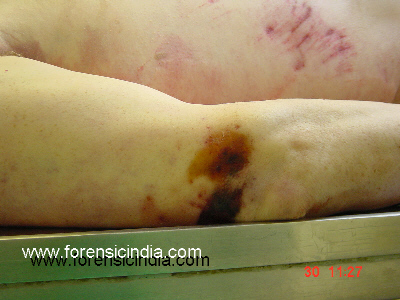
Abrasions
An abrasion is a superficial injury, commonly known as a 'graze' or 'scratch'.
This type of wound damages only the epidermis (uppermost skin layer), and should not therefore bleed. However, abrasions do usually extend into the dermis causing slight bleeding.
Abrasions are commonly caused by a 'glancing' impact across the surface of the skin, but if the force is directed vertically down onto the skin surface it may be termed a 'crush' injury.
These wounds are seen where an object has struck the skin (eg a blow from a fist), or where the injured person has fallen onto a rough surface, such as road.
Abrasions may be 'linear', or commonly known as a single 'scratch', whereas if a broader surface is affected, it is called a 'graze' or 'brush abrasion' (eg where a motorcyclist is thrown from their vehicle, and comes into contact with the road surface in a skidding fashion). Such an abrasion often covers a relatively large area of skin, and is often called a 'friction burn' in lay language.
Examples of abrasions on the arm and trunk of a victim of a road traffic accident ...
Click
on picture to see enlarged view

An example of an abrasion on an elbow, with a light scab forming...found in full technicolour on the Pathguy's site (Ed Friedlander)
Click on picture to see enlarged view
(Other good examples of abrasions can be found in Simpson's Forensic medicine, 1997 p.46)
If the surface of an abrasion is examined closely, for example with a hand-held magnifying glass, the direction of force can often be determined, from the torn epidermis. Strands are drawn towards the end of the injury, and are 'heaped up'. The edges of the wound may also be ragged and directed towards the end of the wound.
Of particular importance in the forensic setting is the fact that abrasions can retain much of the surface characteristics of the object that caused the wound. For example, there may be a patterned abrasion caused by an element of a vehicle involved in a 'hit-and-run' (such as that made by a radiator grill or bumper), and if the abrasion has been fully documented and photographed (with a scale) and the suspected vehicle is subsequently recovered, the two may be matched up.
An excellent example of brush abrasions on the flank due to contact with a road surface can be found in Simpson's Forensic Medicine, 1997 p.81)
This example of brush abrasions can be found in full on Tom Denmark's site. It illustrates a motorcycle fatality, where the victim has come in contact with the road surface.
Click on picture to see enlarged view